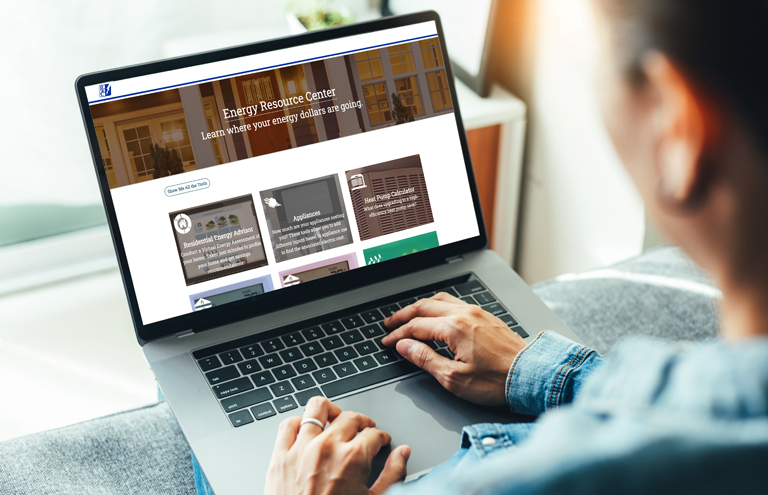Home » Energy-Saving Tips
Energy-Saving Tips
A home that saves energy is a home that saves money. Take the power into your own hands — browse our collection of tips and tools below to keep your home operating efficiently.
What makes up your bill?*
- Cooling and heating: 55%
- Water heater: 20%
- Laundry: 7%
- Refrigerator: 5%
- Lighting: 5%
- Other electric devices: 5%
- Dishwasher: 3%
- Pool: 29%**
Want to see how saving energy can save money on your bill? Use our rate calculator!
*Based on a 2,000-square-foot, all-electric home with a family of three to five using an average of 1,465 kilowatt-hours (kWh) per month. Remember, technology and usage are constantly evolving. This information is based on PEC’s current data for a home built in the last 10 years.
**If applicable. Based on a 2-horsepower pump running 10 hours per day using about 600 kWh per month. This would reduce the percentage of total power used by other electrical equipment in the home.
Tips to save energy
- Test your HVAC unit with a digital thermometer and schedule a tune-up if needed.
- Check your HVAC air filters monthly and replace them when dirty or damaged.
- Keep all supply vents and interior doors open to ensure maximum airflow throughout the house.
- Use weatherstripping to seal air leaks around movable building components, such as doors or operable windows.
- Bump the thermostat 3–5 degrees closer to the outdoor temperature when you leave home for long periods.
- Caulk around all gaps, holes, and stationary components inside and out, including telephone, electrical, cable, gas, water spigots, etc.
- Set thermostats to 68 degrees. If you have a heat pump, don’t increase the temperature by more than 2 degrees at a time.
- Use electric space heaters for area heating in rooms that tend to be cooler than others or if you’re only occupying a small area of your home. Turn space heaters off when leaving the room.
- Open drapes and shades on sunny days.
- Keep the fireplace damper closed when the fireplace is not in use.
- Set thermostats to 78 degrees.
- Turn off ceiling fans when leaving the room. Fans cool people, not spaces.
- Install exterior solar screens on windows that receive direct sunlight.
- Close shades and drapes during the day.
- Turn off bathroom and kitchen exhaust fans 15 minutes after a task is completed.
- Set your water heater temperature to 115-120 degrees.
- Install a timer that shuts off the unit during times you don’t need hot water.
- Insulate exposed water lines.
- Install water-saving showerheads.
- Don’t let hot water run while you are brushing your teeth, doing dishes, etc.
- Install a timer on pool pumps so they run the minimum amount of time needed to maintain water quality.
- Familiarize yourself with the freeze-protection settings on your pool pump to ensure operation only during freezing temperatures.
- Keep the lid on the hot tub to maintain warmth.
Dryer
- Clean the lint trap before each load.
- Check the vent hose twice per year to make sure it’s tightly connected to the dryer and not kinked or clogged.
- Only run the dryer long enough for the clothes to dry.
- In the summer, run the dryer at night.
- Drying loads back-to-back can help harvest heat remaining in the dryer from the previous load.
Washing machine
- Wash clothes in cold water. Use hot water only when necessary.
- Always wash full loads.
- Adjust the water level to match the load size if you have to wash a small load.
- Always use cold-water rinse.
- Set the refrigerator temperature to 34–37 degrees and freezer temperature to 0-5 degrees.
- Clean refrigerator coils annually.
- Switch your refrigerator’s power saver on, if available.
- Ensure refrigerator door seals are tight.
- If you don’t have a frost-free refrigerator, defrost your refrigerator or freezer to avoid ice buildup.
- Replace incandescent bulbs with LED bulbs, especially when used for several hours per day.
- Install timers and sensors for indoor and outdoor lights.
- Turn off unnecessary lighting when not in use.
- Turn off computers, monitors, large-screen TVs, and other electronics when not in use.
- Use energy-saving modes or automatic sleep functions on electronics if you don’t unplug them.
- Plug devices such as TVs, video game consoles, and printers into power strips that can be turned off during long periods of unuse. These devices draw power even when they’re off.
- Use a microwave or slow cooker for cooking when possible.
- Use cold water for the garbage disposal.
- Unplug devices and chargers once your electronics are fully charged.
- Only run full loads.
- In the summer, run the dishwasher at night.
- Do not use the heat-dry feature.

Schedule an over-the-phone energy assessment
Our energy advisors are ready to help you discover energy-saving options throughout your home. Schedule an over-the-phone energy assessment, and one of our experts will provide year-round energy-saving tips to fit your situation.

The power is in your hands
You’ve got the power to monitor your energy use with SmartHub’s My Usage tool! View your consumption, compare it to previous months, years, and weather data, and uncover ways you can save. Go to SmartHub and log in or register for your account.

Analyze your home's efficiency
Use an interactive Home Efficiency Analysis Tool to find quick tips and fixes, designed around your space, to help you cut down on your energy and costs.